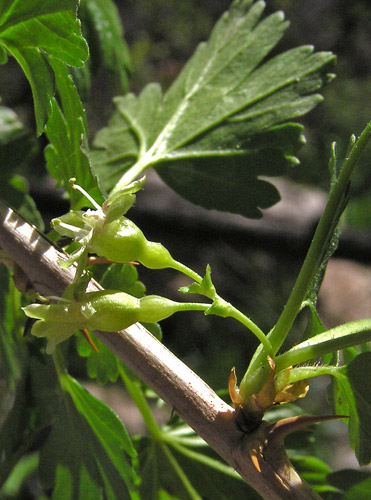Grossulariaceae
|
Grossulariaceae |
|
|
Shrubs, usually deciduous (Ribes speciosum semievergreen, R. viburnifolium evergreen). Leaves alternate, simple; stipules present; petiole present [absent]; blade lobed or cleft (unlobed in R. speciosum and R. viburnifolium), margins toothed [subentire]. Inflorescences terminal or axillary, usually racemes, sometimes corymbs or solitary flowers. Flowers bisexual (unisexual in R. diacanthum); perianth and androecium epigynous; hypanthium wholly or partially adnate to ovary, free distally; sepals usually 5 (R. speciosum 4), connate proximally; petals usually 5 (R. speciosum 4), distinct; nectary disc present; stamens (4-)5, antisepalous, inserted on hypanthium, free or adnate to hypanthium, distinct; anthers introrsely dehiscent by longitudinal slits; pistils 1, 2-carpellate; ovary partly to completely inferior, 1-locular; placentation parietal; ovules anatropous, bitegmic, crassinucellate; styles 2, distinct, connate proximally or nearly completely; stigmas 2, terminal, capitate. Fruits baccate. Seeds (3-)10-60, brown to black, fusiform to oblong-ellipsoid or ellipsoid; embryo straight; endosperm copious, oily, not starchy. Some genera included by A. Cronquist (1981) in Grossulariaceae are now placed in separate families. Of the genera native in the flora area, Itea is placed in Iteaceae, characterized by spirally-arranged serrate leaves, superior ovary, and septicidal capsules, leaving Ribes as the only native genus in Grossulariaceae (P. F. Stevens, http://www.mobot.org/MOBOT/research/APweb/). Escallonia Mutis ex Linnaeus f., which occasionally escapes cultivation in coastal California and Oregon and was included by Cronquist in Grossulariaceae, has entire or glandular-serrate leaves, an inferior ovary, and capsules on which the style and calyx lobes persist. It is placed in Escalloniaceae (see Volume 13), a family of uncertain affinities with about six genera (Stevens).
|
|
